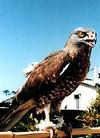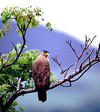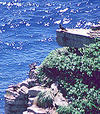Okinawa Birds
 Noguchi-gera (Pryer's woodpecker), Sapheopipo noguchi (Special National Protected Species)
Noguchi-gera (Pryer's woodpecker), Sapheopipo noguchi (Special National Protected Species)
A member of the woodpecker family. It is an extremely rare bird, the only member of its genus in the world.
Occasions have become rarer when the rat-a-tat-tat of the noguchi-gera is heard in the forests of northern Okinawa, and far fewer have been the sightings of this phantom bird. This prefecture is the home of many species of animals nearing extinction, and this woodpecker is near the top of the list. Mentioned in the travelogue of an Englishman by the name of Pryor in 1886, Sapheopipo noguchi was named after Japanese bird collector Noguchi who first identified it in the 19th century.
The only known habitat of the hundred or so remaining Noguchi-gera is the hilly, forested area of northern Okinawa. About 30 centimeters in length, its body has a brown coloring. One differentiation between the male and female is that the male has dark brown feathers from the forehead to the back of the head while the female has black feathers.
In the year of the reversion, 1972, the noguchi-gera was designated a National Natural Treasure, and in the same year was made the prefectural bird. Five years later it was made a Special National Natural Monument.
The bird seldom appears near residential areas, and experts have pointed out that the destruction of their natural habitat is causing a decline in the numbers. Conservation groups are now pressing for measures to preserve the noguchi-gera.
 Yanbaru-kuina (Okinawa rail), Rallus okinawae ( National Protected Species)
Yanbaru-kuina (Okinawa rail), Rallus okinawae ( National Protected Species)
A member of the water rail family, it is very rare worldwide. It is a flightless nocturnal bird.The Yanbaru Kuina is a rare species of bird which lives in the northern mountain areas. The body of one of these birds was discovered on June 2, 1981 in a mountainous area of Kunigami Village. One young and one adult bird were captured on June 28 of the same year by researchers from the Yamashita Institute at the foot of Yonaha Mountain. Old people often said that birds like chickens lived in the northern mountain region of Yanbaru.
The institute checked the birds carefully and reached the conclusion that it was a new species of rail. In January 1981, Mr. Yoshimaro Yamashita and Mr. Toru Yano named it Rallus Okinawae, its scientific name; Okinawa rail in English, and Yanbaru kuina in Japanese. It was the 506th new bird species found in Japan and designated a National Natural Monument in December, 1982.
The average bird weighs about 43 grams and has short wings. The birds cannot fly. Its color from head to tail is brown. The birds have existed in Okinawa for many years. A fossil of the bird was also discovered earlier. In the deep mountain areas, the birds did not need to fly and subsequently lost their ability to fly. The birds stay in trees which are 2 or 3 meters above the ground. The birds eat earthworms, frogs, snails, and lizards. The Yanbaru kuina is used as a mascot for many events. This mascot is a little, plump figure, but charming, and looks like a typical Okinawan man.
 Sashiba On its autumnal migratory flight during October and November from mainland Japan to the Philippines, the sashiba, a kind of hawk, never fails to make a stopover in the Miyako Islands. Irabu Island in the Miyako Island group is especially known as a temporary rest place for this long-distance traveler.
Sashiba On its autumnal migratory flight during October and November from mainland Japan to the Philippines, the sashiba, a kind of hawk, never fails to make a stopover in the Miyako Islands. Irabu Island in the Miyako Island group is especially known as a temporary rest place for this long-distance traveler.
After spending the period from spring to early fall in the lower mountains and hilly regions of central Honshu, Kyushu and Shikoku breeding and raising their chicks, flocks of Sashiba gather at Cape Sata, Kagoshima Prefecture to prepare for their southward migration. Their flight, taking them over Tokunoshima and other islands in the Ryukyu Island chain, follows a route that once a year passes through prefectural skies and brings them down for a breather in Miyako.
In earlier times, residents of Miyako hunted them for food; they were even sold in Naha markets. It is said that Sashiba rice porridge was delicious. The birds also became pets for children. Their numbers have been decreasing because of hunting and diminution of their high forest habitat although now the sashiba is protected by an international treaty applying to the hunting and capture of migratory birds.
 SHORT-TAILED ALBATROSS The short-tailed albatross is a large seabird whose wingspan approaches 2m. Until the late 19th century, Short-tailed albatrosses formed large colonies on Tori-shima, and the Ogasawara and Senkaku islands. However, because of the demand for their feathers, the short-tailed albatrosses were recklessly hunted and were believed to be extinct until a small number were later rediscovered on Tori-shima and Minami-kojima of the Senkaku Islands. Thanks to conservation efforts, the numbers have gradually increased to about 1,000. The Short-tailed Albatross is easy to catch because it moves slowly and does not fear human beings. For this same reason, the bird gets its nickname, Aho-dori, which literally means "idiot bird." Flying over the ocean as if gliding along the surface, the short-tailed albatross, catches fish and squid for food.
SHORT-TAILED ALBATROSS The short-tailed albatross is a large seabird whose wingspan approaches 2m. Until the late 19th century, Short-tailed albatrosses formed large colonies on Tori-shima, and the Ogasawara and Senkaku islands. However, because of the demand for their feathers, the short-tailed albatrosses were recklessly hunted and were believed to be extinct until a small number were later rediscovered on Tori-shima and Minami-kojima of the Senkaku Islands. Thanks to conservation efforts, the numbers have gradually increased to about 1,000. The Short-tailed Albatross is easy to catch because it moves slowly and does not fear human beings. For this same reason, the bird gets its nickname, Aho-dori, which literally means "idiot bird." Flying over the ocean as if gliding along the surface, the short-tailed albatross, catches fish and squid for food.
Short-tailed Albatross (Diomedea albatrus) This species has had its numbers increased through protection and breeding activities of the Environment Agency and Hiroshi Hasegawa of the Yamashina Institute for Ornithology, and has been placed in the Threatened II group. However its future is unpredictable.
 Okinawa Crested Serpent Eagle This is the largest member of the Washi-Taka genus that inhabits Okinawa. It can be as long as 55cm. The islets of Yaeyama are its only habitat in Japan and also the northernmost habitat for its kind. Crested serpent eagle literally means "an eagle with a crown". It is named for the long feathers on top of its head that look like a crown. It lives at the foot of the mountains or in the woods near rivers, and eats rats, birds, snakes, lizards, and crabs.
Okinawa Crested Serpent Eagle This is the largest member of the Washi-Taka genus that inhabits Okinawa. It can be as long as 55cm. The islets of Yaeyama are its only habitat in Japan and also the northernmost habitat for its kind. Crested serpent eagle literally means "an eagle with a crown". It is named for the long feathers on top of its head that look like a crown. It lives at the foot of the mountains or in the woods near rivers, and eats rats, birds, snakes, lizards, and crabs.
 RYUKYU WOOD PIGEON This 40 cm-long dove is the largest dove to inhabit Japan. It usually lives alone in woods in various places in Okinawa. It has red legs and dark colored feathers, which display a metallic purple or green sheen in the light. The particular type living in the Miyako and Yaeyama regions is called Yonakunikarasubato and is designated as a special species of bird. Japanese wood pigeons make sounds similar to the calls of cows. It is reported that it drinks seawater, just like the Japanese green pigeon.
RYUKYU WOOD PIGEON This 40 cm-long dove is the largest dove to inhabit Japan. It usually lives alone in woods in various places in Okinawa. It has red legs and dark colored feathers, which display a metallic purple or green sheen in the light. The particular type living in the Miyako and Yaeyama regions is called Yonakunikarasubato and is designated as a special species of bird. Japanese wood pigeons make sounds similar to the calls of cows. It is reported that it drinks seawater, just like the Japanese green pigeon.
 Honto-akahige (Ryukyu robin), Erithacus komodori namiyei (National Protected Species)
Honto-akahige (Ryukyu robin), Erithacus komodori namiyei (National Protected Species)
A sedentary bird of the sparrow order and flycatcher family.
 Karasu-bato (Japanese wood pigeon), Columba janthina janthina (National Protected Species)
Karasu-bato (Japanese wood pigeon), Columba janthina janthina (National Protected Species)
This bird has an all-black body with a purplish head. The breast is speckled with green and flashes of silver. It is an extremely wary bird, very difficult to approach.
 Amami-yamashigi (Amami woodcock), Scolopax mira (Prefectural Protected Species)
Amami-yamashigi (Amami woodcock), Scolopax mira (Prefectural Protected Species)
A large bird of the snipe family.
 Konoha-zuku (Scops Owl), Otus scops japonicus
Konoha-zuku (Scops Owl), Otus scops japonicus
A bird of the owl family believed to be the smallest of the Japanese owls. The photograph is of an adult and young.
